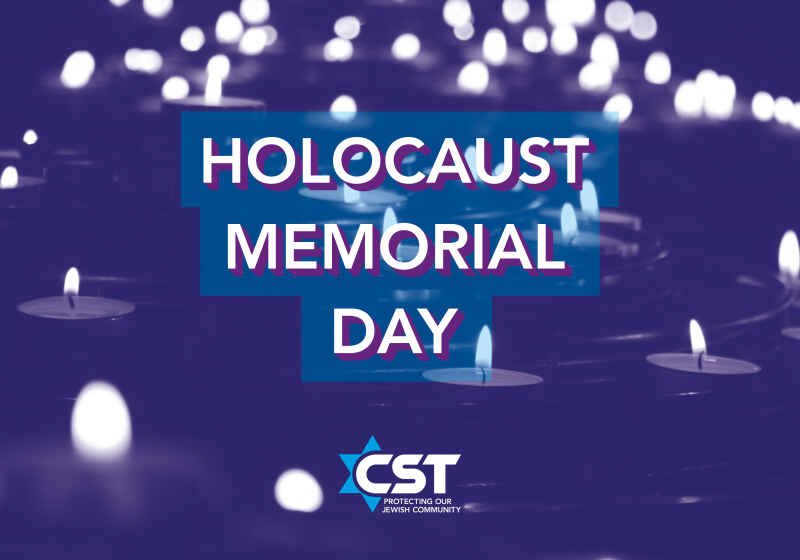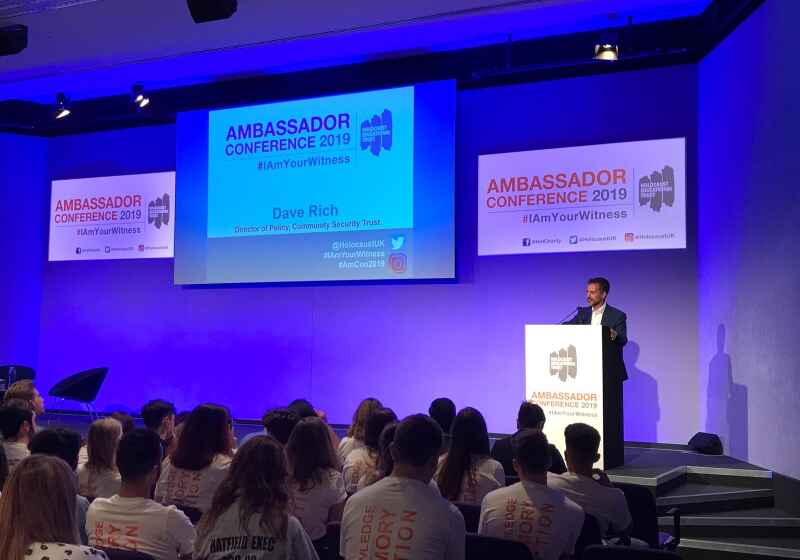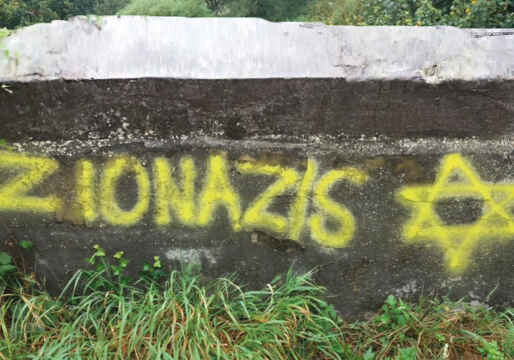CST Blog
Genocide Abuse Day
18 January 2013
With Holocaust Memorial Day (27th January) fast approaching, so does its annual bastardisation by our local pro-Iranian and pro-Hizbollah fans, the Islamic Human Rights Commission.
(See previous CST blog for IHRCs role in Londons annual version of the Iranian-inspired anti-Israel hate festival, Quds Day, replete with Hizbollah assault rifle flags.)
Unlike the Iranian regime and its Press TV outlet, the Islamic Human Rights Commission is not so stupid or crass as to engage in outright denial that the Holocaust ever happened, but the group is still stuck between a rock and a hard place: how to acknowledge the reality of the Holocaust, without lending legitimacy to the most basic and blatant of arguments in favour of Zionism?
The far left have tackled this problem by keeping Jewish victimhood centre stage, whilst alleging that Zionists wanted the Holocaust and/or actually colluded with the Nazis to bring it about. They turn the moral tables on Zionism, by claiming that Zionists needed and desired and worked towards dead Jews in order to gain global sympathy for their enterprise.
The pro-Iranian IHRC, however, prefer the tactic of declaring a Genocide Memorial Day. This year it is subtitled "Remembering Man's Inhumanity to Man" and will be held on 20th January. The day's title enables the IHRC to gently subsume the genocide of European Jewry under the sheer scale of mans inhumanity to man. Challenge this as sophistry and you are forced into a somewhat nauseating comparative study in human suffering.
As a bonus ball, IHRC also get to define and blur the meanings of the word genocide and the phrase "man's inhumanity to man". So, they include Palestinian suffering and seamlessly move Palestinians and Israelis onto the same moral planes as Jews and Nazis.
In 2011, CST blog detailed that years IHRC Genocide Memorial Day calendar. For brevity, here are four of the entries:
January Gaza: During the Israeli assault on Gaza during the 22 Day war (2008 09), 1,434 Palestinians were killed of which 288 were children and 181 were women. A further 5,303 Palestinians were injured in the assault, including 1,606 children and 828 women.
April Auschwitz: Estimates of numbers of Roma and Sinti people killed by the Nazis in the second world war range from 200,000 to 500,000.
October Treblinka: The Treblinka concentration camp was set up by the Nazis in Occupied Poland. Between July 1942 and October 1943, 800,000 people were killed there, the majority of whom were Jewish, and a substantial number of whom were Roma.
November Palestine: The Nakba (The Catastrophe) refers to the events of 1948 when Israel was created. That year saw the mass deportation of a million Palestinians from their cities and villages, massacres of civilians, and the razing to the ground of hundreds of Palestinian villages.
Note how the Gaza and Palestine entries balance those of Treblinka and Auschwitz. Note how Treblinka mentions Jews and Roma, whilst Auschwitz mentions Roma and not Jews. Note how Treblinka seeks to play up the Roma element, despite the overwhelming majority of its victims having been Jewish. (I write this to show the IHRCs underhand ghastliness, not to diminish the dreadful suffering of Roma and Sinti.) Note how there is no actual mention of the Holocaust, nor of gas chambers. The spin is both subtle and repugnant.
This year, to mark Genocide Memorial Week 2013, we have a cutesy little animation video on the IHRC website. (It can be viewed here, but does not need to be.)
The animation shows an adorable child holding a red balloon. The childs ethnicity and religion gradually changes (including Jewish and Muslim). The child is simply drawn in a charming and naive style, walking along without a care in the world to the tune of a happy background jingle. At the foot of the animation runs a series of childrens names that begins with Ann Frank (Germany). This is followed by Renate Wolff (Germany) and Agnes Ringwald (Hungary), before listing one Kurd, two Guatemalans, two Japanese and two Australians, then ending with Mutassim Muhammad Ali Samour (Gaza).
The name Ann Frank (Germany) (sic) is, of course, very well known. It immediately establishes for the viewer what the other names are all about. Unavoidably, your awareness is heightened that you do not actually recognise most, or perhaps any, of the other names scrolling along the screen. This causes you to pay greater attention to them. You cannot help asking yourself, why dont I know these other names and what tragedies have they suffered?. (In actuality, not all of those listed were actually murdered in genocides and some of them are still alive. Again, this is to be forced into a comparative study of human suffering.)
The names change as the animated child also changes. As the words Muhammad Ali Samour (Gaza) appear, so the screen explodes blood red and the music changes to gunfire. The words Sabra & Shatilla are now stamped on the blood red background, with the figure 3,500. Next, there is Srebrenica 8,000, then Nazi Holocaust 11,000,000.
So this year, the IHRC did actually mention three Jewish child victims of the Holocaust by name and they did draw a sweet picture of a boy in a kippah. The Nazis six million Jewish victims are, however, conveniently subsumed within the larger figure of eleven million victims. Why commemorate the ethnocentric six million total, when you can commemorate the universalist eleven million total? (Whether this eleven million figure is even accurate is another, not unrelated, matter. See for example here.)
In all, 16 events and death tolls appear. Having begun with "Sabra & Shatilla 3,500", the list ends with Gaza 2009 over 1,000. The opening and closing sections are the only ones that relate to Palestinians. It is their victimhood that literally brackets all of the other entries: this is subtle stuff, but it is highly effective and, as with the 2011 calendar, it moves Palestinian suffering centre stage and places it on an equal, or even higher plane, than that of Jewish suffering. The message is as subtle as it is unmistakeable; and the IHRC's motivations for Genocide Memorial Day are shown up for being not quite as universalist as they would have you believe.
The Iranian regime (and indeed the far left) could learn a great deal from this sleight of hand. Will the IHRC advise them to follow suit?
Finally, it should be noted that when searching Genocide Memorial Day on Google, the top result is a Wikipedia entry saying that this is a national holiday in Armenia. Curiously neither this, nor any Armenian children, feature in the IHRCs video.


